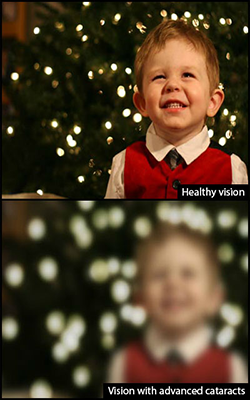American Academy of Ophthalmology offers tips to help people considering whether to have the procedure
Nearly 25.7 million Americans over age 40 have cataracts and the number is projected to increase to 45.6 million by 2050.1 While the only way to remove cataracts – a clouding of the eye’s lens – is surgery, the right time to have surgery depends on the individual patient. In support of Cataract Awareness Month, the American Academy of Ophthalmology is offering tips for those who have been diagnosed with cataracts as they consider whether to have surgery to remove them and when.
 Cataracts occur as part of the body’s natural aging process. Being diagnosed with cataracts does not always mean that surgery is immediately required. In the early stages, cataracts may not change vision significantly and minor changes may be improved with prescription glasses. But as the cataracts continue to mature over time, they may cause vision loss that can interfere with daily life.
Cataracts occur as part of the body’s natural aging process. Being diagnosed with cataracts does not always mean that surgery is immediately required. In the early stages, cataracts may not change vision significantly and minor changes may be improved with prescription glasses. But as the cataracts continue to mature over time, they may cause vision loss that can interfere with daily life.
Although the prospect of cataract surgery can be intimidating, the procedure itself is the most common elective surgery among Medicare beneficiaries in the United States. Multiple studies have demonstrated its association with improved quality of life, reduced risk of falling and fewer car crashes.2,3,4 In addition, one study found that those who had cataract surgery had a 40 percent lower long-term mortality risk than those who did not.5
The American Academy of Ophthalmology has developed a list of four questions people should consider to help determine if they’re ready for cataract surgery:
Are your cataracts impacting your daily or occupational activities?
Symptoms of cataracts include dim, blurry or yellowed vision and can even double vision in a single eye. The lack of contrast and clarity can be difficult for those who need clear vision for work, driving or who enjoy hobbies like reading, cooking or sewing.
Are your cataracts affecting your ability to drive safely at night?
Cataracts can cause halos around lights and difficulty seeing in low-light settings, impacting the ability to safely drive at night. Advanced cataracts can even cause enough vision loss to fail the vision test required for a driver’s license.
Are your cataracts interfering with the outdoor activities you enjoy?
Cataracts can also increase sensitivity to glare, which can be especially troublesome for those who enjoy skiing, surfing and a number of other outdoors activities. They can also cause visual differences from one eye to the other, which can affect the distance vision golfers need.
Can you manage your cataracts in other ways?
Those who decide to put off cataract surgery can make the most of their vision with a few simple tools, such as incorporating brighter lighting and contrasting colors in the home. Polarized sunglasses and a wide-brimmed hat can reduce glare, while magnifying lenses can make reading easier.
“If cataracts aren’t disrupting your life, you can probably wait and have surgery when they really start to bother you,” said Ravi D. Goel, M.D., cataract surgeon and a clinical spokesperson for the American Academy of Ophthalmology. “But for those who are feeling impeded by their blurry or dulled vision, the procedure can make a significant beneficial impact.”
Cataract surgery is only recommended when the outcome is expected to improve vision, unless the cataracts obscure treatments for other eye diseases. Those considering cataract surgery should discuss how cataracts are affecting their daily lives with an ophthalmologist. Learn more about cataract risks, symptoms and treatments at www.aao.org/eye-health/diseases/what-are-cataracts.
About the American Academy of Ophthalmology
The American Academy of Ophthalmology, headquartered in San Francisco, is the world's largest association of eye physicians and surgeons, serving more than 32,000 members worldwide. The Academy's mission is to advance the lifelong learning and professional interests of ophthalmologists to ensure that the public can obtain the best possible eye care. For more information, visit www.aao.org.
The Academy is also a leading provider of eye care information to the public. The Academy's EyeSmart® program educates the public about the importance of eye health and empowers them to preserve healthy vision. EyeSmart provides the most trusted and medically accurate information about eye diseases, conditions and injuries. OjosSanos™ is the Spanish-language version of the program. Visit EyeSmart or OjosSanos to learn more.
1 http://forecasting.preventblindness.org/
2 http://www.ncbi.nlm.nih.gov/pubmed/22978526?dopt=Abstract
3 http://www.ncbi.nlm.nih.gov/pubmed/22851116
4 http://www.ncbi.nlm.nih.gov/pubmed/22273356
5 https://www.aaojournal.org/article/S0161-64201300143-7/fulltext